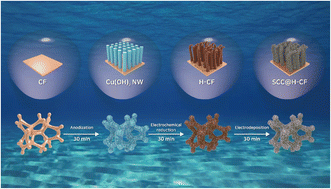Ultrathin electrochemical layer tailoring of lithiophilic materials with 3D hierarchical configuration for lithium metal batteries: Sn/Cu6Sn5@Cu2+1O nanowires on Cu foam†
Abstract
Lithium (Li) metal has outstanding electrochemical properties and is a promising anode material for next-generation Li batteries, owing to its large specific capacity and low reduction potential. However, the inhomogeneous deposition of Li on the host leads to dendrite growth with safety hazards, limiting its potential application. In this study, we propose hierarchical Cu2+1O nanowires with ultrathin Sn/Cu6Sn5 composites formed on copper foam, which were prepared in 90 min by a fully electrochemical wet process with high cycling stability. Cu2+1O nanowires converted from Cu(OH)2 offer a large surface area to distribute the surface charge uniformly with a low local current density, whereas the ultrathin Sn/Cu6Sn5 composite with a high affinity for Li induces uniform nucleation over the entire surface of the host without reducing the energy density. Consequently, the symmetric cell can be cycled for more than 3000 h at a current density of 0.5 mA cm−2 with a low voltage hysteresis of 8 mV, confirming the enhanced stability of Li deposition. Furthermore, a full cell with a LiFePO4 (LFP) cathode exhibited superior cycling stability and rate performance. This approach demonstrates a low-cost and time-saving industrially applicable process via a fully electrochemical wet method to regulate the harmless lateral growth of Li dendrites.



 Please wait while we load your content...
Please wait while we load your content...